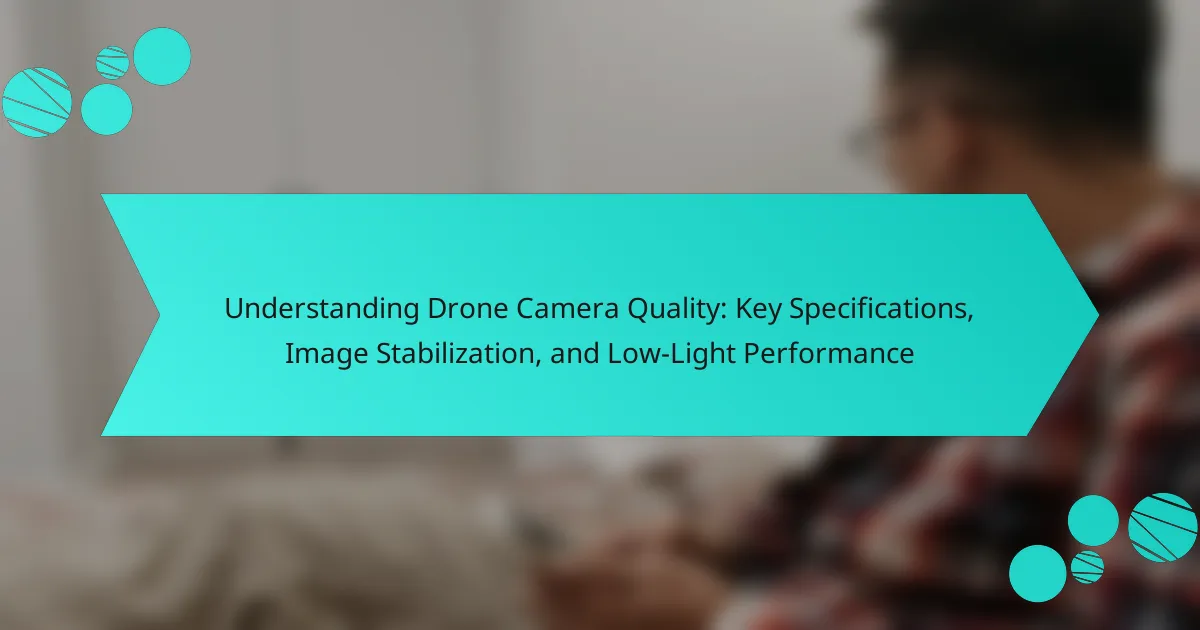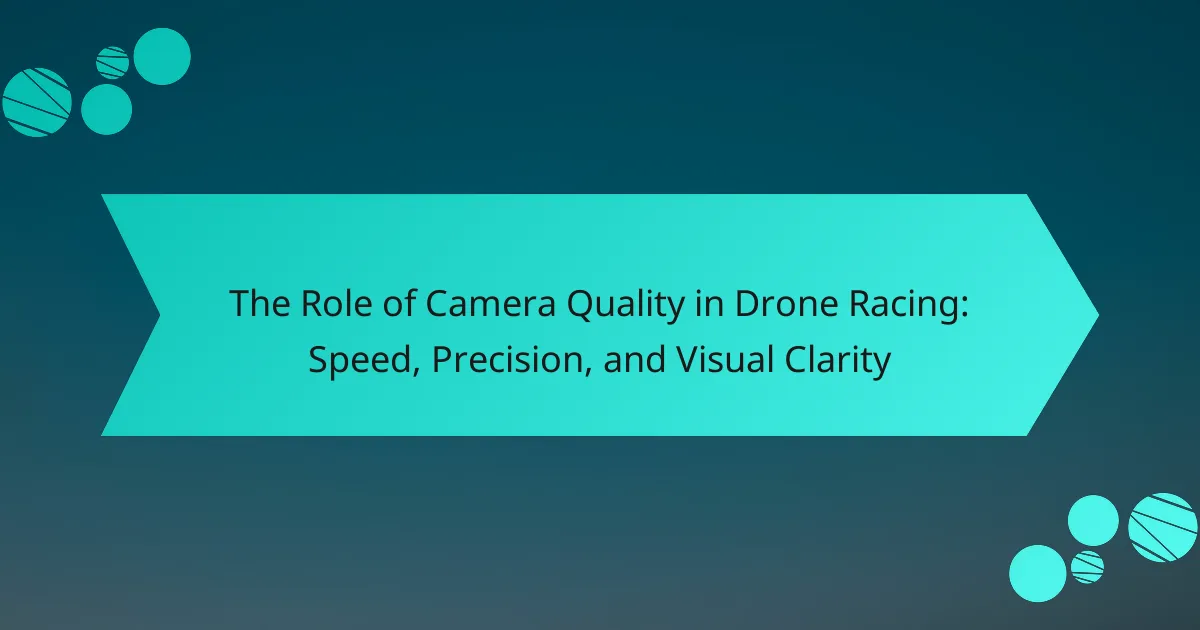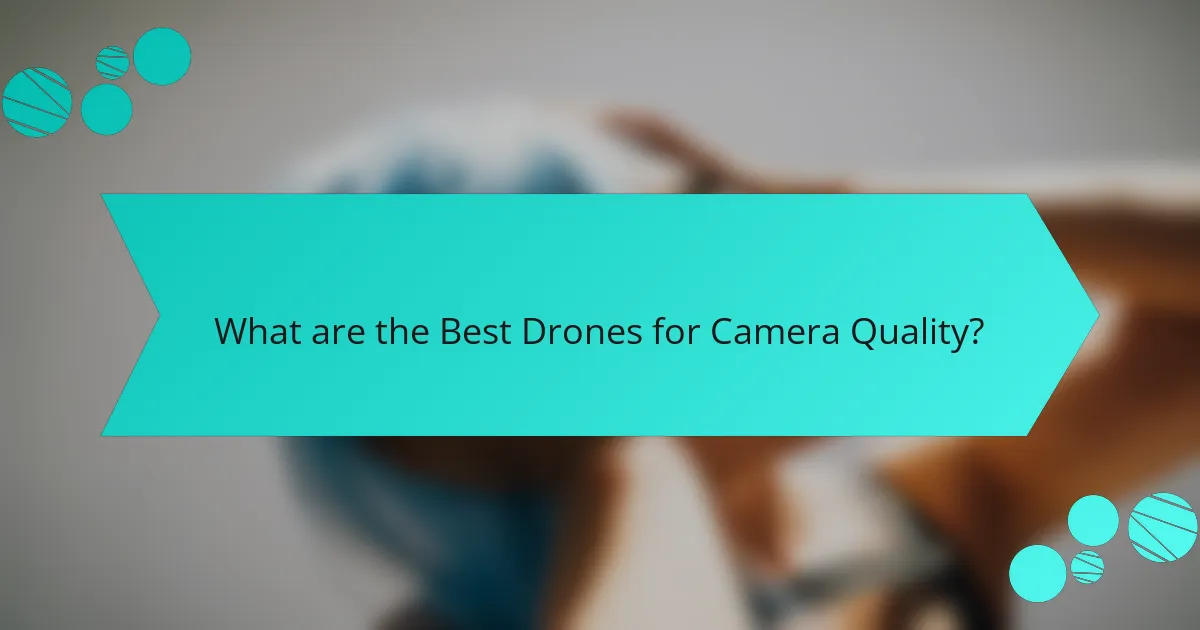
What are the Best Drones for Camera Quality?
The best drones for camera quality include the DJI Mavic 3, DJI Air 2S, and Autel Robotics EVO Lite+. The DJI Mavic 3 features a 20 MP Hasselblad camera with a 4/3 sensor. It captures 5.1K video at 50 fps. The DJI Air 2S offers a 1-inch sensor with 20 MP resolution. It records 5.4K video at 30 fps. The Autel EVO Lite+ has a 50 MP camera and can shoot 6K video at 30 fps. These drones are recognized for their superior imaging capabilities and advanced features.
How do camera specifications influence drone performance?
Camera specifications significantly influence drone performance by determining image quality, stabilization, and operational capabilities. Higher resolution cameras provide clearer images and better detail, which is crucial for aerial photography. The sensor size impacts low-light performance; larger sensors capture more light, improving image quality in dim conditions. Lens quality affects sharpness and distortion, influencing the overall visual output.
Frame rate specifications influence video smoothness; higher frame rates yield smoother motion capture. Autofocus systems enhance the ability to capture sharp images, especially in dynamic environments. Additionally, the presence of features like optical zoom allows for versatile shooting without compromising image quality.
Battery consumption is also affected; high-performance cameras may drain batteries faster, impacting flight time. Thus, camera specifications are critical in determining the overall effectiveness and capabilities of a drone in various scenarios.
What are the key camera specifications to consider?
Key camera specifications to consider include sensor size, resolution, lens quality, and aperture. Sensor size affects image quality and low-light performance. Larger sensors typically capture more light, resulting in better images. Resolution, measured in megapixels, determines the detail in photos. Higher resolution allows for larger prints without losing clarity. Lens quality influences sharpness and distortion. A high-quality lens enhances overall image fidelity. Aperture, represented by f-stop numbers, controls light entering the camera. A lower f-stop allows more light, improving performance in dim conditions. These specifications collectively impact the overall camera performance in drones.
How do different sensor types affect image quality?
Different sensor types significantly affect image quality in various ways. The size of the sensor influences the amount of light captured. Larger sensors generally produce clearer images with less noise in low light conditions. Sensor technology, such as CMOS versus CCD, impacts dynamic range and color accuracy. CMOS sensors typically offer faster processing speeds and better power efficiency. The pixel size on the sensor also plays a crucial role. Larger pixels can gather more light, enhancing image quality, especially in challenging lighting. Additionally, sensor resolution determines the level of detail captured in an image. Higher resolution sensors can produce more detailed images, but may also require more storage space. Overall, the choice of sensor type directly correlates with the resulting image quality in drones.
What are the top-rated drones for camera quality?
The top-rated drones for camera quality include the DJI Mavic 3, the DJI Air 2S, and the Autel EVO Lite+. The DJI Mavic 3 features a Hasselblad camera with a 20 MP sensor and can record 5.1K video. The DJI Air 2S has a 1-inch sensor and captures 20 MP images, also supporting 5.4K video. The Autel EVO Lite+ boasts a 50 MP camera and can record 6K video. These drones are frequently praised for their exceptional image quality and advanced features.
Which brands are known for high-quality camera drones?
DJI, Autel Robotics, and Parrot are known for high-quality camera drones. DJI is the market leader, recognized for its advanced technology and superior camera capabilities. The DJI Mavic series, for instance, offers 4K video and excellent stabilization. Autel Robotics provides competitive options like the EVO series, which also features 4K video and robust flight performance. Parrot’s Anafi drone is noted for its lightweight design and 4K HDR video capabilities. These brands consistently receive positive reviews for their camera quality and user-friendly features.
What are the standout models in the market?
The standout models in the market for drones with excellent camera quality include the DJI Mavic 3, Autel Robotics EVO Lite+, and the Skydio 2. The DJI Mavic 3 features a Hasselblad camera with a 4/3 CMOS sensor, providing stunning image quality. The Autel EVO Lite+ offers a 1-inch sensor capable of 50 MP images and 6K video. The Skydio 2 is known for its advanced obstacle avoidance and impressive AI tracking features. These models are widely recognized for their superior camera capabilities and user-friendly interfaces.
How do user experiences shape perceptions of drone quality?
User experiences significantly shape perceptions of drone quality. Positive experiences often lead to high ratings and favorable reviews. Users tend to evaluate factors such as flight stability, camera performance, and ease of use. High-quality user experiences can enhance brand reputation. Conversely, negative experiences may result in poor reviews and decreased sales. A study by the Journal of Consumer Research found that firsthand user feedback directly influences potential buyers’ perceptions. This feedback loop is crucial in the drone market, where consumer trust is vital. As users share their experiences online, they create a collective understanding of what constitutes quality in drones.
What common feedback do users provide about camera drones?
Users commonly provide feedback regarding camera drones’ image quality, ease of use, and battery life. Many users praise the high-resolution images and stable video footage produced by these drones. They often mention the intuitive controls that make flying accessible for beginners. However, users frequently express concerns about the limited flight time due to battery constraints. Additionally, some feedback highlights issues with connectivity and signal loss during operation. These factors contribute to overall user satisfaction and dissatisfaction with various models.
How do user reviews influence purchasing decisions?
User reviews significantly influence purchasing decisions by providing firsthand insights into product performance. Consumers often rely on reviews to gauge quality and reliability. According to a study by BrightLocal, 91% of consumers read online reviews before making a purchase. Positive reviews can enhance a product’s credibility and increase sales likelihood. Conversely, negative reviews can deter potential buyers. Reviews also help potential customers compare products, especially in categories like drones where quality varies. This trend underscores the importance of user-generated content in shaping consumer perceptions and choices.
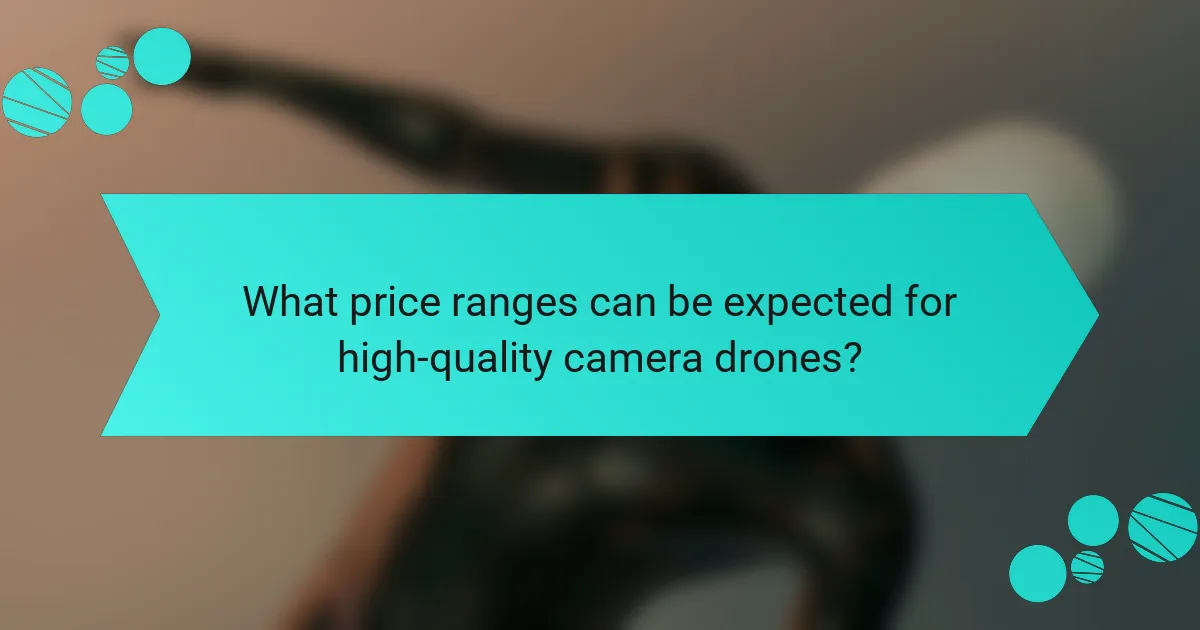
What price ranges can be expected for high-quality camera drones?
High-quality camera drones typically range from $500 to $3,000. Entry-level models with decent camera capabilities start around $500. Mid-range options with advanced features can cost between $1,000 and $2,000. Professional-grade drones often exceed $2,000, reaching up to $3,000 or more. These prices reflect the quality of materials, technology, and camera specifications. For example, drones with 4K video capabilities and longer flight times tend to be priced higher.
How does price correlate with camera quality in drones?
Price generally correlates positively with camera quality in drones. Higher-priced drones typically feature advanced camera specifications. These specifications include higher resolution sensors, better lens quality, and enhanced stabilization systems. For instance, drones priced above $1,000 often have 4K video capability and larger sensors. In contrast, budget drones under $500 may only offer 720p or 1080p video resolution. Additionally, premium drones often include features like HDR imaging and improved low-light performance. This trend is supported by consumer electronics market analysis, which indicates that camera technology improves with increased investment. Thus, as the price of drones rises, so does the quality of their cameras.
What are the budget-friendly options for camera drones?
Budget-friendly options for camera drones include models like the Holy Stone HS720, Potensic D80, and DJI Tello. The Holy Stone HS720 offers 4K video quality and GPS features at a price around $300. The Potensic D80 provides 1080p HD video and a 1200mAh battery for about $200. The DJI Tello, priced around $100, is compact with 720p video capabilities. These drones are popular for their affordability and decent camera performance. They cater to beginners and casual users seeking quality without high costs.
What features justify higher price points in premium models?
Higher price points in premium drone models are justified by advanced camera systems, enhanced flight capabilities, and superior build quality. Premium drones often feature high-resolution cameras, such as 4K or 8K, enabling exceptional image clarity. They may include larger sensors for better low-light performance and dynamic range. Advanced stabilization technology, like gimbals, ensures smooth footage during flight.
Flight time is generally longer in premium models, often exceeding 30 minutes, which allows for more extensive shooting sessions. Premium drones also offer advanced navigation systems, including GPS and obstacle avoidance, enhancing safety and ease of use.
Build quality is typically superior, with materials that resist weather and damage, ensuring durability. Features like intelligent flight modes, automated tracking, and live streaming capabilities further enhance functionality. These attributes collectively contribute to the higher price point, making premium drones more suitable for professional use.
What are the average costs across different drone categories?
The average costs across different drone categories vary significantly. Consumer drones typically range from $300 to $1,500. Professional drones can cost between $1,500 and $5,000. High-end commercial drones may exceed $5,000, reaching up to $20,000. Racing drones are generally priced between $200 and $1,000. Each category reflects varying features and capabilities. For instance, camera quality and flight time influence pricing. These costs are based on market trends and consumer reports from 2023.
How do consumer drones compare to professional models in pricing?
Consumer drones are generally more affordable than professional models. Consumer drones typically range from $100 to $1,500. In contrast, professional drones can cost anywhere from $2,000 to over $10,000. The price difference reflects the advanced features and capabilities of professional models. Professional drones often include superior camera quality, enhanced stability, and longer flight times. Additionally, professional drones may have specialized software for complex tasks. This pricing structure highlights the varying needs of hobbyists versus professionals in the drone market.
What are the additional costs associated with owning a camera drone?
Additional costs associated with owning a camera drone include maintenance, insurance, and accessories. Maintenance costs can arise from wear and tear on components. Battery replacements are often necessary as they degrade over time. Insurance can protect against damages or loss, with annual premiums varying based on coverage. Accessories like extra batteries, propellers, and carrying cases can add to initial expenses. Additionally, software for editing and managing footage may incur costs. Training or certification for safe operation can also be a financial consideration. These costs can significantly impact the overall investment in a camera drone.
What are the best practices for buying a camera drone?
When buying a camera drone, consider several best practices. First, assess your budget. Camera drones range significantly in price, from a few hundred to several thousand dollars. Second, evaluate the camera quality. Look for drones with at least 4K video capability for high-resolution footage. Third, check the flight time. Most drones offer 20 to 30 minutes of flight time per battery. Fourth, consider the range. A good drone should have a control range of at least 1,000 meters. Fifth, review the drone’s stability features. Drones with GPS and obstacle avoidance are easier to control. Sixth, research user reviews. Feedback from other users can provide insights into performance and reliability. Lastly, ensure compliance with local regulations. Many areas require registration for drones above a certain weight. These practices will help ensure you make an informed purchase.
How should one evaluate the value of a drone before purchase?
To evaluate the value of a drone before purchase, consider its specifications and features. Key attributes include camera quality, flight time, range, and ease of use. Assess the camera resolution, stabilizing features, and additional functionalities like gimbal support. Check the drone’s battery life, as longer flight times enhance usability. Review the operating range to ensure it meets your needs. Investigate user experiences and reviews for real-world performance insights. Compare prices across different models to identify the best value. Research warranty and customer support options to ensure reliability after purchase.
What tips can help ensure a satisfactory drone experience?
To ensure a satisfactory drone experience, always check local regulations before flying. Understanding the laws helps avoid fines and legal issues. Additionally, perform a pre-flight inspection of the drone. This includes checking the battery level and propellers for damage. A fully charged battery is essential for longer flights.
Using a designated flying area enhances safety and enjoyment. Open spaces reduce the risk of collisions. Familiarize yourself with the drone’s controls before flying. Practice in a safe environment to build confidence.
Weather conditions play a crucial role in flight safety. Avoid flying in strong winds or rain, as these can affect control. Lastly, keep the drone within visual line of sight. This practice ensures better control and awareness of surroundings.
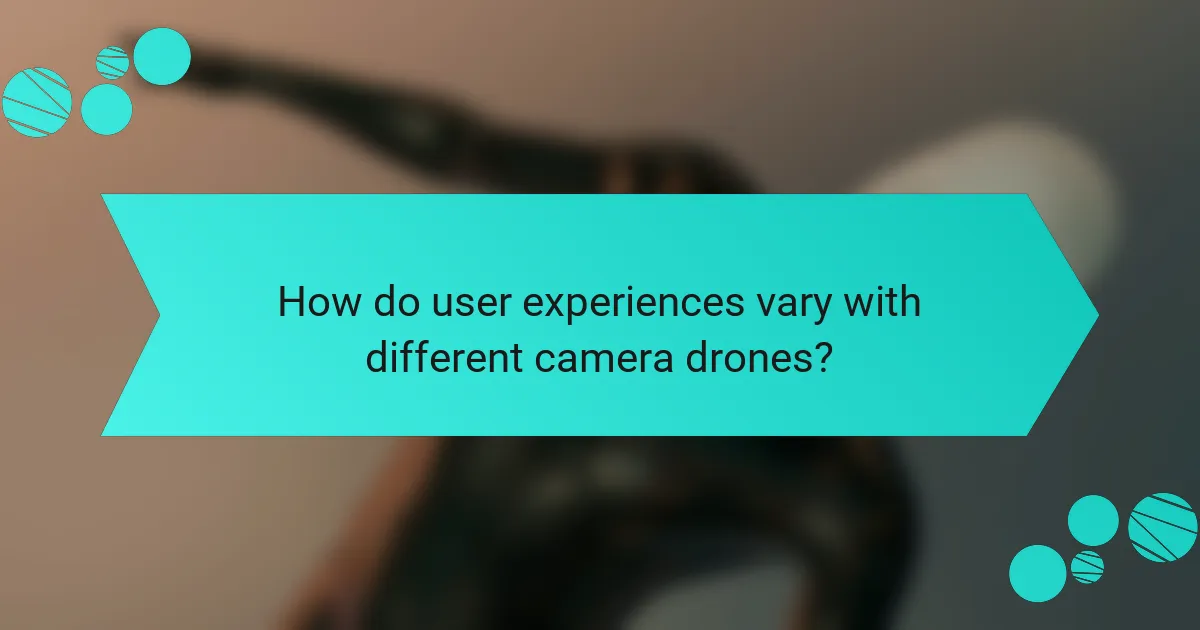
How do user experiences vary with different camera drones?
User experiences with different camera drones vary significantly based on features and usability. Higher-end drones, such as the DJI Mavic series, often provide superior image quality and stabilization. Users report better performance in low-light conditions with these models. In contrast, entry-level drones may lack advanced features, resulting in less satisfactory image quality. Users often find them easier to fly but may experience limitations in camera capabilities. Battery life also affects user satisfaction; premium models typically offer longer flight times. Additionally, software and app integration can influence user experience, with some drones providing more intuitive controls and editing options. Overall, the choice of camera drone greatly impacts user experiences based on performance, features, and ease of use.
What are the most common use cases for camera drones?
Camera drones are commonly used for aerial photography and videography. They capture high-quality images and videos from unique perspectives. These drones are popular in real estate for showcasing properties. They are also utilized in film and television production for stunning aerial shots. Additionally, camera drones assist in surveying and mapping land for construction projects. They provide valuable data in agriculture for crop monitoring. Furthermore, they are used in search and rescue operations to locate missing persons. Lastly, camera drones enhance sports coverage by capturing dynamic action shots.
How do different users utilize camera drones for photography?
Different users utilize camera drones for photography in various ways. Professional photographers use drones to capture aerial shots for real estate, weddings, and events. They benefit from high-resolution images and unique perspectives. Hobbyists often explore landscapes and nature, enjoying the creative freedom drones offer. They can experiment with angles and compositions not achievable from the ground. Filmmakers employ drones for dynamic video footage, enhancing storytelling with sweeping aerial views. Surveyors and engineers utilize drones for mapping and inspections, providing detailed imagery for analysis. Each user group tailors drone capabilities to meet specific photographic needs, demonstrating the versatility of camera drones in photography.
What are the unique experiences reported by professional photographers?
Professional photographers report unique experiences related to using drones for aerial photography. They highlight the ability to capture stunning landscapes from new perspectives. Many note the ease of accessing hard-to-reach locations. Photographers often mention the creative freedom drones provide in framing shots. They also appreciate the high-resolution images produced by modern drone cameras. Some report challenges with battery life and flight regulations. Others emphasize the learning curve associated with piloting drones effectively. Overall, these experiences illustrate the transformative impact of drones on photography.
What challenges do users face with camera drones?
Users face several challenges with camera drones. One significant challenge is battery life. Most consumer camera drones have a flight time of 20 to 30 minutes. Weather conditions also pose difficulties. Wind can destabilize the drone and affect image quality.
Another challenge is regulatory compliance. Users must adhere to local laws regarding drone flight. This can include restrictions on where and when drones can be flown.
Technical issues can arise as well. Users often encounter connectivity problems between the drone and the controller. Additionally, camera drones can be expensive to maintain. Repair costs can add up if the drone is damaged.
Finally, users may struggle with the learning curve. Operating a drone requires practice and skill. Many beginners find it challenging to master the controls and camera settings.
What are the common technical issues encountered by users?
Common technical issues encountered by users of drones include connectivity problems, battery life concerns, and camera malfunctions. Connectivity issues often arise due to weak signals, especially in remote areas. Users frequently report difficulties in maintaining a stable connection between the drone and the remote controller. Battery life is another common issue, with many users experiencing shorter flight times than advertised. This can be due to factors like temperature and weight. Camera malfunctions can include focus problems and image stabilization failures. These technical issues can hinder the overall user experience and affect the quality of captured footage.
How do users overcome obstacles related to drone regulations?
Users overcome obstacles related to drone regulations by staying informed and compliant with local laws. They often research specific regulations that apply to their area. Many users join online forums or local drone clubs for shared knowledge. They utilize apps that provide real-time information on no-fly zones and airspace restrictions. Users also attend workshops or training sessions to understand regulations better. Some opt for obtaining necessary licenses or certifications to operate legally. By adhering to guidelines set by aviation authorities, users ensure safe flying practices. Compliance reduces the risk of fines or penalties associated with illegal drone use.
What are the most helpful resources for new drone users?
The most helpful resources for new drone users include online tutorials, user manuals, and community forums. Online tutorials provide step-by-step guidance on drone operation and safety. User manuals offer detailed specifications and instructions for specific drone models. Community forums allow users to share experiences and ask questions. Websites like YouTube host numerous instructional videos. The Drone Pilot Ground School provides courses for FAA certification. Additionally, drone-specific blogs and review sites offer insights into best practices and user experiences. These resources enhance knowledge and improve flying skills.
Where can users find tutorials and guides for camera drones?
Users can find tutorials and guides for camera drones on various online platforms. Websites like YouTube offer numerous video tutorials covering different drone models and techniques. Drone manufacturers also provide official guides on their websites. Online forums and communities, such as DJI forums or Reddit, host discussions and shared experiences. Educational websites and blogs dedicated to drone photography often publish detailed tutorials. Additionally, online courses on platforms like Udemy or Skillshare teach drone operation and photography skills.
What community forums offer support for drone enthusiasts?
Popular community forums that offer support for drone enthusiasts include DJI Forum, RC Groups, and DronePilots. The DJI Forum caters specifically to users of DJI products, providing a platform for discussions on features and troubleshooting. RC Groups is a broader forum that encompasses various remote-controlled devices, including drones, allowing for diverse discussions and shared experiences. DronePilots focuses on aerial photography and videography, making it ideal for enthusiasts interested in camera quality. These forums are valuable resources for knowledge sharing and community support among drone users.
The main entity of the article is high-quality camera drones, specifically focusing on models like the DJI Mavic 3, DJI Air 2S, and Autel Robotics EVO Lite+. The article provides an overview of the best drones for camera quality, detailing their specifications, performance, and features that influence image quality. It discusses user experiences, common challenges faced by drone users, and the impact of camera specifications on overall performance. Additionally, the article covers price ranges, budget-friendly options, and best practices for purchasing and operating camera drones, offering a comprehensive guide for potential buyers and enthusiasts.


